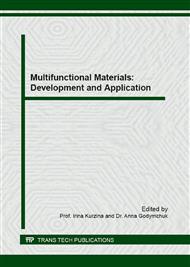p.402
p.406
p.415
p.419
p.427
p.433
p.440
p.447
p.454
Study of Biological Properties of Thin-Film Materials on the Basis of the SIO2–P2O5–СaO System
Abstract:
Thin films were obtained from film-forming solutions by the sol-gel method on the basis of the SiO2-P2O5-СаO system. Thin films were produced on the single-crystal silicon substrates (model substrate) by extraction at a velocity of 5 mm/s following by heat treatment at a temperature of 60°С for 20 minutes and at a temperature of 600°С for 1 hour. During the experiment it was established that film-forming solutions are usable only for 2 to 7 days from the moment of preparation. Using thermal and infra-red – spectroscopic analysis main stages of oxide system formation were retraced. According to data from x-ray phase analysis phases CaClH2PO4∙H2O, Ca(H2PO4)2∙H2O, CaHPO4∙2H2O, Ca2SiO4∙H2O, Ca5(PO4)3Cl. On the supporter’s surface a homogeneous film coating with quite equally spaced crystal-like formations with the diameter of 10-11 microns at the distance of 1-30 microns was formed. Phase composition, surface properties and biological activity of the synthesized materials were investigated. XRD results indicated that after being immersed into the SBF, hydroxylapatite, wollastonite, and chlorapatite were formed on the samples’ surfaces, which was important for practical applications
Info:
Periodical:
Pages:
427-432
Citation:
Online since:
February 2016
Price:
Сopyright:
© 2016 Trans Tech Publications Ltd. All Rights Reserved
Share:
Citation:


